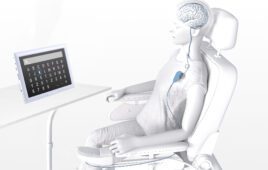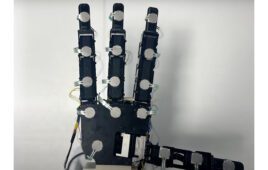 Walking is tricky business, as any toddler knows. And while most artificial feet and limbs do a pretty good job restoring mobility to people who have lost a leg, they have a ways to go before they equal the intricacy of a natural gait. As a result, over half of all amputees take a fall every year, compared to about one-third of people over 65.
Walking is tricky business, as any toddler knows. And while most artificial feet and limbs do a pretty good job restoring mobility to people who have lost a leg, they have a ways to go before they equal the intricacy of a natural gait. As a result, over half of all amputees take a fall every year, compared to about one-third of people over 65.
In cooperation with a Mayo Clinic scientist, researchers at Michigan Technological University are taking a giant step toward solving the problem. They are making a bionic foot that could make an amputee’s walk in the park feel, well, like a walk in the park.
The secret lies in the ankle. Mo Rastgaar, an assistant professor of mechanical engineering–engineering mechanics, and PhD student Evandro Ficanha are working on a microprocessor-controlled ankle-foot prosthesis that comes close to achieving the innate range of motion of this highly complex joint.
These computerized artificial legs have pressure-sensitive sensors on the bottom of the foot that detect how the amputee is walking. The sensors instantaneously send signals to a microprocessor, which in turn adjusts the prosthesis to make walking more natural.
The microprocessor-controlled prostheses on the market can move an artificial foot in only one direction, toe up and toe down, which is fine if you are marking time on a treadmill, said Rastgaar. “But in reality, we never walk in a straight line for any length of time,” he said. “When you walk and reach an obstacle, you have to turn, and there’s always something in our way.”
So, Rastgaar and Ficanha designed an ankle-foot that can move on two axes, incorporating a side-to-side roll as well as raising the toe up and down. And they moved the power and control mechanism up and away from the leg using a cable-driven mechanism. That lightens the prosthesis, making it much more comfortable and easy to use.
The cable that moves the prosthetic ankle-foot is similar to those used in bicycle brakes. It runs from the control box to the ankle mechanism and can turn the foot in almost any direction.
As part of their study, the team designed and built a large circular treadmill on which the robotic foot “walks” in circles. In tests, the prosthetic was able to copy the angles of a human ankle walking in a straight line and turning.
Kenton R. Kaufman, director of the Biomechanics/Motion Analysis Laboratory at the Mayo Clinic in Rochester, Minn., is collaborating in the effort to refine the prosthesis and make it available to amputees, especially wounded warriors.
“Artificial limbs tend to evolve from wars because of the increased awareness of the problems faced by amputees,” said Kaufman. A primary focus is improving safety. “Amputees have lots of problems with falling; 64 percent of above-the-knee amputees fall every year, compared to 33 percent of older adults,” he said.
The latest generation of microprocessor-controlled prosthetics is a step in the right direction. “They provide active control of the joint and improve safety and function,” Kaufman said. “But the advantage of Mo’s foot is that it is biomimetic—it mimics biology—so it allows a more natural walking pattern to occur, which should result in a better gait and fewer falls.”
The researchers expect to begin refining their design at the Mayo Clinic in summer 2014. They will present a paper on their work, “Ankle Angles during Step Turn and Straight Walk: Implications for the Design of a Steerable Ankle-Foot Prosthetic Robot,” at the 2013 ASME Dynamic Systems and Control Conference, to be held Oct. 21-23 at Stanford University.




